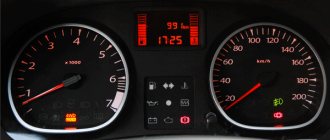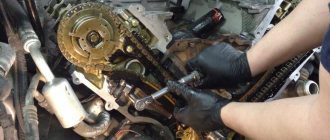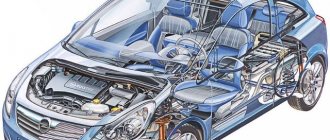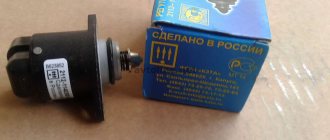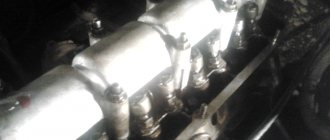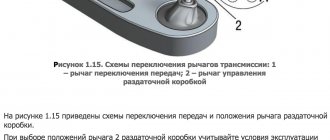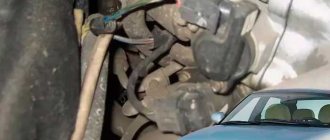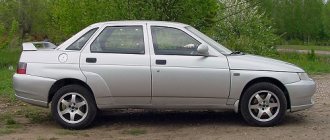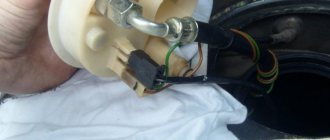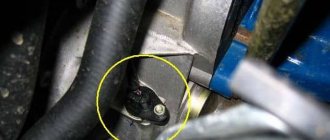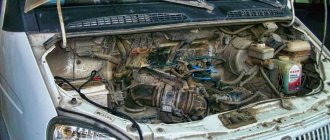It happens that the car jerks at idle and low speed, and when the tension is applied, the problem disappears. Such symptoms appear on automatic and manual transmissions. The car vibrates and has trouble picking up speed.
The most common reason for a car to stall at idle is considered to be driver inexperience. When the gear is engaged, the driver releases the gas pedal, which provokes a decrease in the mixture supplied to the cylinders. When the rotation speed drops to a critical level, a power failure occurs - this is the source of trouble. After accelerating or applying a load, the engine levels out and the car drives normally.
However, there are also more significant problems.
- The fuel line, carburetor jets, injector nozzles are clogged, or the tightness of the pipes is compromised. Such little things can seriously unbalance the unit.
- Another “root of evil” may be hidden in the engine mounts. If the cushion is worn out or loose, vibrations from the unit are transmitted to the vehicle body.
- Air supply problems. A clogged air filter, a leaf of wood caught in the intake. As a result, an over-enriched air-fuel mixture is formed and the engine shakes.
Diagnostics
Checking the power plant is done in this way.
Fastenings
Check that all bolts are in place and that they are tightened. Sagging cushions and loose axles in 60% of cases provoke the transfer of vibration to the body, imbalance of the internal combustion engine.
Fuel system
Checking the fuel lines is necessary to eliminate air leaks. Leaked bubbles are the primary source of interruptions in the normal engine stroke. For example, on a VAZ 2110 the “sore” is located in the fastenings of the fine fuel filter. It is also necessary to diagnose the carburetor or injector. A grain of sand stuck in an injector or jet prevents the normal flow of gasoline and disrupts the operation of the installation.
Bad fuel
Low-quality fuel is a common cause of car jerking and instability of engine speed. This usually appears a short time after refueling. The problem can only be solved by draining the fuel and flushing the entire system.
Engine
The next common problem is wear or incorrect adjustment of the main components of the power plant. Clogged strokes, a worn piston group or broken bearings can cause more than just jerking of the machine.
The problem of feeding the engine with the fuel-air mixture
Also a common reason for visiting a service station. Problems in the fuel and air supply system guarantee an unstable supply of the mixture to the combustion chamber. The result is a jerking of the car, floating speed of the power plant.
The problem can be resolved by diagnosing all elements of the fuel line, replacing filters, and checking the functionality of the fuel pump.
Engine management system
The following problem is relevant for vehicles equipped with an ECM. Sensitive electronics often malfunction due to wetness, mechanical damage, system errors, or incorrect sensor readings.
The fault can only be eliminated through computer diagnostics.
Electrics
The most common category of diseases is found in the electrical circuits of the machine. Here the master is required to consistently study the entire structure, from spark plugs to the ignition coil. On the injector you need to look at the ECM and then the ECU.
It is also important to measure the fuel rail pressure for the injector.
Ignition system
The most common cause in the system is wear of spark plugs and high-voltage wires. The ignition coils or electronics may also malfunction.
Diagnostics must be performed from the final element (plug) and along the line to the fuses.
Incorrectly set car ignition
The ignition timing affects the ignition point of the fuel mixture. If the adjustment is made late or too early, the engine loses power, jerks or stalls. A secondary symptom is the appearance of detonation.
Gearbox failure
If the gears in the device are ground, this can cause them to slip, and as a result, shocks when driving.
This is also often accompanied by extraneous sounds, vibration, and possibly knocking out of gears.
Damage to the accelerator (gas pedal)
Hall sensors and PCV sensors may work intermittently, which gives a false signal to the ECU.
If the problem is in electronics, you need to perform computer diagnostics, where all errors will be revealed.
In the event of a mechanical breakdown, all parts are thoroughly washed, dirt is removed and the equipment is repaired. Usually the problem occurs due to contamination of the damper drive.
Transmission breakdowns
Transmission units often cause the car to jerk during acceleration. When the car reaches a stable speed, the trouble is felt less or disappears altogether.
Why does the engine jerk at low and idle speeds?
So, if the car jerks at idle, there may be several reasons for such a malfunction. Most often, problems affect the ignition system and power supply system; less often, elements of the engine control system or parts inside the internal combustion engine fail.
Damage to the insulation of high-voltage wires when a spark “breaks through” also leads to similar symptoms in the form of motor twitching. The ignition coil, switch, ignition module, and distributor also deserve additional attention. Depending on which ignition system is installed on a particular engine, all its elements must be checked one by one.
Note that usually the fuel system is the culprit for dips and jerks when the internal combustion engine is operating under load, however, even in idling mode, there may be insufficient fuel or it is supplied to the engine intermittently. Step by step it is necessary to check the carburetor and its adjustments, the injector and individual elements of the system, the fuel pump, etc.
The fact is that if the air filter is dirty, the engine may not have enough oxygen to prepare the correct fuel-air mixture. The same is true in cases where airing occurs in the power system or excess air is sucked in at the inlet.
In any case, the mixture may turn out to be too rich or lean, and the normal and timely combustion of such a charge in the cylinder does not occur. At the same time, in such a situation, the spark plugs become even more covered with soot, and sparking further deteriorates.
If any sensor fails, cylinder misfires or other failures occur, then the internal combustion engine control system on some cars immediately informs the driver about this. At the same time, not always, in the event of various malfunctions of the ECM elements and other breakdowns, a “check” on the dashboard may light up, an error code will be displayed on the screen of the on-board computer, etc. The error is recorded only in the ECU memory, but in order to read the error code in this case, you will need to separately carry out computer diagnostics.
In case of incorrect operation and malfunction of the regulator, as well as in the accumulation of a large amount of dirt and carbon deposits on the damper, the idle speed becomes unstable. In this case, the engine not only jerks, but the idle speed often fluctuates greatly.
Source
What to do
If the engine jerks at idle, the cause should initially be determined. Then replace the damaged unit.
For carburetor models, the primary diagnosis begins with the throttle and the combustible mixture formation unit itself. Usually on old foreign cars and VAZs the root of evil is located here. If the problem arose on a modern VAZ 2114/15 or on an “exotic” model like 1JZ-GE. The source of the problem may be inside the sensors. First of all, the DPKV, temperature sensor, temperature control system and others are checked. If everything is in order, you need to move on. High-voltage wires, spark plugs, and the ECM are diagnosed, and the ECU is checked last.
It is also necessary to pay attention to the condition of the filter elements; obstruction in the flow of air or fuel also causes an imbalance of the engine at the bottom.
The car jerks at idle and when driving
If the problem occurs not only while parked, but also while driving, it is necessary to check the ignition, carburetor, and serviceability of the throttle valve.
Important! The engine may run intermittently during warm-up - this is not considered a deviation from the norm.
For the injector, diagnostics of the fuel rail, its pressure, tightness, and the condition of the injectors are appropriate.
Also in both cases, the electronic part is diagnosed: control units, distributor, wiring, spark plugs.
The malfunction is caused by a failure, incorrect operation, of one of the vehicle systems.
The injector jerks
Main reasons:
- injectors or individual fuel supply elements are clogged;
- ignition coils are not working properly;
- The ECU and sensors are not functioning correctly.
The carburetor jerks
Everything is simpler with a carburetor. Here's what you should check:
- throttle valve condition;
- filters;
- spark plugs;
- distributor;
- Is the fuel pump working correctly?
At idle the car jerks and stalls
This problem is relevant not only for the domestic automobile industry.
Owners of modern cars may encounter it - Lancer 9/10, Toyota Camry and others. If the engine does not idle during a cold start in winter, there is nothing terrible - the block will warm up and everything will return to normal. However, if there is a failure after warming up, there may be several reasons for the breakdown.
- Idle air control failure.
- Clogged, throttle malfunction.
- The carburetor and jets are clogged (the injectors are checked for the injector).
- The fuel supply pump is faulty.
- The air/fuel filter is worn out.
- Failure of the electronic sensor MRV, TPS, DPKV.
The car shakes at idle
If vibration is transmitted to the car body, the first step is to check the wear of the power plant mounts. Squashed cushions do not reliably hold the engine in place, which causes severe shaking, deviation of the internal combustion engine from the nominal position and, as a result, vibration.
Other causes of shaking are described above.
The car shakes and jerks at idle
The process of engine tripping is a consequence of the malfunction of one or more cylinders. A similar breakdown is caused by a failure of the spark plug or a breakdown of the high-voltage wire.
Diagnostics is carried out like this.
- With the engine running, remove the spark plug cap from the first cylinder.
- After 3-4 seconds, install the element in place.
- Consistently repeat the procedure for all boilers.
During the check, you must listen to the sound of the engine. If the growling gets worse (the system doubles), the compartment is fine. If the result is neutral (nothing has changed), it is worth checking the line completely for serviceability.
The primary source of failure may be the following reasons:
- incorrect mixture setting - the cylinder floods;
- spark plug or wiring is of poor quality;
- occurrence of rings;
- piston wear.
Diesel car jerks at idle
There can be only three reasons here.
- The cylinder compression has dropped. As a rule, this occurs due to burnout of the cylinder head gasket and wear of the piston group elements.
- Injector problems - poor mixture supply, blockages, intake failure.
- Malfunction of the injection pump.
The car on gas jerks at idle
In the case of a gas-powered car stalling, the source is in the gas reducer or in a damaged line.
If a breakdown is detected, it is strictly not recommended to interfere with the unit yourself. You must contact a qualified gas fitter.
Interruptions on a cold engine
If the engine stalls at idle and then levels out after warming up, don’t worry too much. When cold, the power plant does not have normal clearances and can operate unstably. After reaching the design temperature, the motor stabilizes and stops twitching.
The engine jerks at idle: the main reasons
The idle mode involves the operation of the internal combustion engine at the lowest speeds, when the gas pedal is not pressed and air is supplied to the cylinders bypassing the throttle valve. As a rule, in idle mode, the power unit does not transmit torque to the wheels of the car, since this mode is activated when the car is parked with the engine running, when coasting in neutral gear, as well as when the clutch is depressed to change gear, etc. .d.
During the operation of vehicles with various types of engines and power systems (gasoline, diesel, injection, carburetor), a fairly large number of drivers are faced with the fact that the engine jerks at idle. In other words, in this mode, the power unit operates unevenly, twitching can be sharp, short-term or long-lasting, strong or barely noticeable, with noticeable vibrations in the body, etc.
Moreover, it is typical for such a problem that when the speed increases or after the engine begins to load, the symptoms disappear. Otherwise, the engine twitching disappears after the internal combustion engine switches to another operating mode. Next, we'll talk about why the engine jerks at idle, as well as how to detect and fix the problem.
A little about the correct setting of the ignition on a VAZ
On classic Ladas, the ignition timing is set by the advance angle - by rotating the distributor. The figure below shows the factory marks by which the device is installed.
conclusions
The car jerking at idle is a dangerous phenomenon for the internal combustion engine itself. You can fix the problem yourself; you don’t need high-precision, complex tools or in-depth knowledge of engineering.
Such problems can be prevented by adhering to service intervals, regularly inspecting the engine and using high-quality consumables.
Specialization : Graduated from the State Automobile University, worked for 20 years at GAZ-56, now I drive a Zhiguli.
